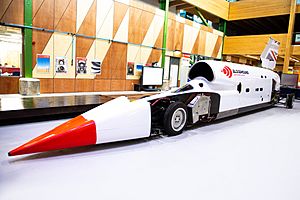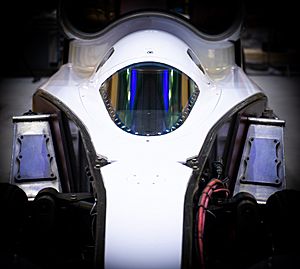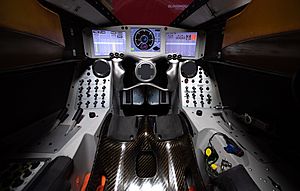Bloodhound LSR facts for kids
Quick facts for kids Bloodhound LSR |
|
|---|---|
 |
|
| Overview | |
| Manufacturer | Grafton LSR Ltd, Bristol |
| Assembly | UK Land Speed Record Centre, Berkeley, Gloucestershire, England |
| Body and chassis | |
| Class | Land speed record vehicle |
| Powertrain | |
| Engine | Rolls-Royce Eurojet EJ200 afterburning turbofan |
| Dimensions | |
| Wheelbase | 8.9 m (29 ft) |
| Length | 12.9 m (42 ft) |
| Width | 2.5 m (8.2 ft) |
| Height | 3.0 m (9.8 ft) |
| Weight | 6,422 kg (14,158 lb) fuelled |
| Chronology | |
| Predecessor | ThrustSSC |
The Bloodhound LSR, once known as Bloodhound SSC, is a special British car built to go super fast. Its main goal is to break the world land speed record. This arrow-shaped car has been in the works since 2008. It uses a powerful jet engine and will also have an extra rocket engine. The team first wants to go faster than the current record of 763 mph (1,228 km/h). They believe the car can even reach speeds up to 1,000 miles per hour (1,609 km/h)!
The driver, Andy Green, will try to break his own record from 1997. The company behind the project faced financial problems in late 2018. But a businessman named Ian Warhurst bought the car to keep the dream alive. A new company, Grafton LSR Ltd, was created to run the project. It was renamed Bloodhound LSR and moved to SGS Berkeley Green University Technical College. Due to a lack of money and the COVID-19 pandemic, progress slowed down in 2020. In 2021, the car was put up for sale.
The place where the car does its super-fast tests and tries to break the world record is called the Hakskeen Pan. It's in the Northern Cape, South Africa. They found a flat area 12 miles (19 km) long and 3 miles (4.8 km) wide that was perfect. The first test runs happened in October 2019. In November 2019, the car reached an amazing speed of 628 miles per hour (1,011 km/h). This made it the eighth vehicle ever to go over 600 miles per hour (970 km/h) on land.
Contents
Building a Speed Machine: Bloodhound's Journey
How the Bloodhound Project Started
The Bloodhound project was announced on 23 October 2008. This happened at the London Science Museum. Lord Drayson, a UK government minister, first suggested the idea in 2006. He talked to land speed record holders Richard Noble and Andy Green. Andy Green is also a pilot in the RAF. These two men have held the land speed record since 1983.
In 1983, Richard Noble, an engineer and adventurer, drove a jet-powered car called Thrust2 to 633 mph (1,019 km/h) in the Nevada desert. Then, in 1997, he led the project to build ThrustSSC. Andy Green drove ThrustSSC to 763 mph (1,228 km/h). This car was the first land vehicle to break the sound barrier! Andy Green is also the driver for Bloodhound LSR.
The project was named after the Bristol Bloodhound missile. This is because Ron Ayers, who designs how the Bloodhound car moves through the air, used to work on that missile project.
The Bloodhound project first started in Bristol, next to a famous ship called the SS Great Britain. Later, in 2013, it moved to a bigger place in Avonmouth. The main offices then moved to Didcot, Oxfordshire, in late 2015.
Early Tests in 2017
The Bloodhound car had its first runway tests in Cornwall, England. These tests happened on 26, 28, and 30 October 2017. During these runs, the car reached speeds of up to 200 miles per hour (320 km/h).
New Owners in 2018
In May 2018, the team planned to do high-speed tests at 500–600 mph (800–970 km/h) in May 2019. They then hoped to reach 1,000 mph (1,600 km/h) in 2020. However, the company supporting the project ran into financial trouble in late 2018. They needed £25 million, which put the project's future in doubt.
The project was almost stopped in December 2018, with plans to sell off its parts. But later that month, Ian Warhurst, a businessman from Yorkshire, stepped in to save it. He bought the car and all its designs and ideas for an unknown amount of money.
High-Speed Runs in 2019
In March 2019, it was announced that Ian Warhurst had started a new company called Grafton LSR Ltd. This company now owns the car and manages the project. The company said that Warhurst was trying to save the project by finding new sponsors and partners.
The new team was named 'Bloodhound LSR', which stands for Land Speed Record. The car and the project's main offices moved to SGS Berkeley Green University Technical College in Berkeley, Gloucestershire.
The car had its high-speed tests at the Hakskeen Pan in October and November 2019. Test runs, driven by Andy Green, started on 25 October. At first, they only used the Rolls-Royce Eurojet EJ200 engine, hoping to reach 400–500 mph (640–800 km/h). On 6 November 2019, the car hit 501 mph (806 km/h). Its final top speed on 16 November was 628 mph (1,011 km/h). This made it the eighth vehicle to ever go over 600 mph on land.
What Happened from 2020 to 2022
In 2020, there wasn't enough money to add the special Nammo rocket. This, along with the COVID-19 pandemic, meant the car couldn't run in 2021. In January 2021, Ian Warhurst said the car was for sale, and the team had moved on to other projects. Warhurst stepped down as CEO in August 2021. Stuart Edmondson, who had been the project's Engineering Operations Manager, took over. In July 2022, Stuart Edmondson said that while the Bloodhound LSR project was on hold, it was "very much alive." He added that a new land speed record could be set quickly if new money was found. Edmondson also mentioned that the project now focuses on the environment, aiming for a net zero carbon land speed record.
The car is currently kept at the Coventry Transport Museum.
How Bloodhound LSR is Built
The Car's Design
The Bloodhound LSR car was designed by Ron Ayers, who works on how the car moves through the air, and Mark Chapman, the Chief Engineer. They also worked with experts from Swansea University.
Bloodhound LSR is designed to go from 0 to 800 mph (1,300 km/h) in just 38 seconds! To slow down, it uses airbrakes at around 800 mph. Then, a parachute helps at speeds up to 650 mph (1,050 km/h). Below 200 mph (320 km/h), it uses regular disc brakes. When the car speeds up, the driver feels a force of 2.5 g. This means he feels two-and-a-half times his body weight pushing him back. When it slows down, it can be up to 3 g.
How it Moves Through the Air
The way Bloodhound is shaped has been carefully planned. This is to make sure the car is safe and stable, especially because it will create a shockwave when it breaks the sound barrier.
The College of Engineering at Swansea University helped a lot with the car's shape. Their team used special computer programs called Computational Fluid Dynamics (CFD). These programs helped them understand how the car would move through the air at all speeds. They could predict the forces on the car and how stable it would be. This technology was first used for airplanes and was also used for the ThrustSSC car.
Engines and Power
The project was given three jet engines, called Eurojet EJ200s, which were made for the Eurofighter Typhoon jet. These engines were originally going to a museum! The car uses one EJ200 jet engine to provide about half the power and get the car up to 650 mph (1,050 km/h). For the world land speed record attempts, a special rocket designed by Nammo will add extra power. When they try for the 1,000 mph (1,600 km/h) runs, this rocket will be replaced with a different type called a hybrid rocket from Nammo. A third engine, a Jaguar supercharged V-8, helps power the rocket's fuel pump. This will eventually be replaced by an electric motor.
At first, Bloodhound SSC was going to use a special hybrid rocket motor designed by Daniel Jubb. This rocket was successfully tested in 2012. However, because of costs, time, and testing places, they decided to use a rocket from a Norwegian company called Nammo instead.
The first plan was for the car to use a Nammo hybrid rocket or a group of rockets. These would be powered by solid fuel and liquid fuel. This plan changed in 2017, and the car will now use a simpler rocket for the land speed record runs.
For the car to reach 800 mph (1,300 km/h), the rocket needs to produce about 40 kN (8992 lbf) of push. The EJ200 jet engine needs to produce 90 kN (20,232 lbf) when it's using its afterburner.
The Wheels
For the slower tests in 2017, the car used four wheels similar to those on an English Electric Lightning fighter jet, with old but fixed tires. For the high-speed tests in the South African desert in 2019, these were replaced. The new wheels are 90-centimetre (35 in) wide and weigh 95 kg (209 lb) each. They are made from a strong aluminum metal used in aircraft. These wheels are designed to spin incredibly fast, up to 10,200 revolutions per minute. They also need to handle huge forces, up to 50000 g at their edge, without breaking apart.
Wheel Bearings
Each wheel has three special Timken bearings that can handle very high speeds. Even though the car's weight increased to 7,500 kg (16,500 lb), these bearings are designed to last for 50 hours of use. This is much longer than the less than 1 hour of actual running time the car will have.
Where Bloodhound is Tested
Early in the project, Swansea University helped find a new place to test the car for record runs. The old test site for the ThrustSSC record was no longer suitable. The chosen place for high-speed testing and record attempts is the Hakskeen Pan in South Africa. It has a track 12 miles (19 km) long. The local community worked hard, clearing 16,500 tonnes of stones by hand from a huge area. This created space for 20 tracks, each 10 meters wide, because the car cannot run on the same strip of desert twice.
Slower runway tests, reaching over 200 mph (320 km/h), happened on 26, 28, and 30 October 2017 at Cornwall Airport Newquay.
High-speed testing at Hakskeen Pan started in October 2019. The car reached 628 mph (1,011 km/h) on its final run on 16 November 2019.
Inspiring Future Scientists and Engineers
The Bloodhound Project also has a big education part. It aims to inspire young people to get interested in science, technology, engineering, and mathematics (STEM). They do this by showing how exciting these subjects are and by working with students. Bloodhound Education Ltd is a separate charity that provides these activities. Their education center is at SGS Berkeley Green UTC.
See also
 In Spanish: Bloodhound SSC para niños
In Spanish: Bloodhound SSC para niños
- Aussie Invader 5R
- List of vehicle speed records
- North American Eagle Project




